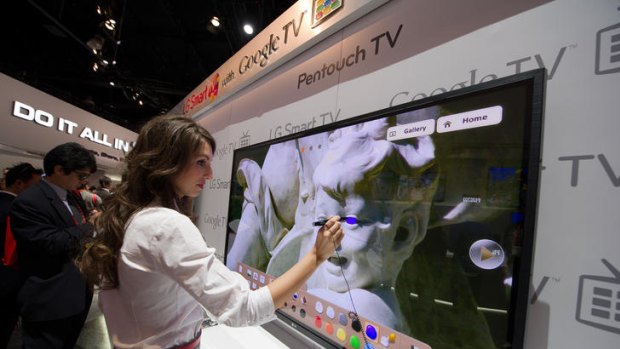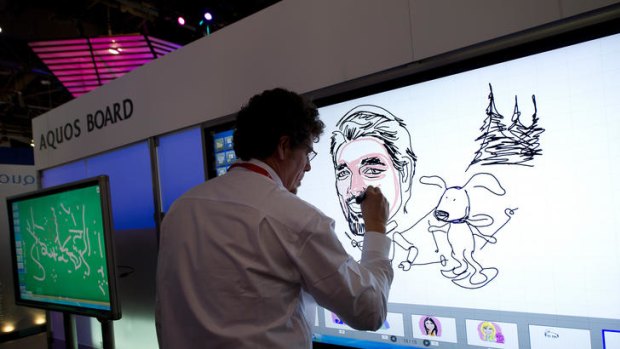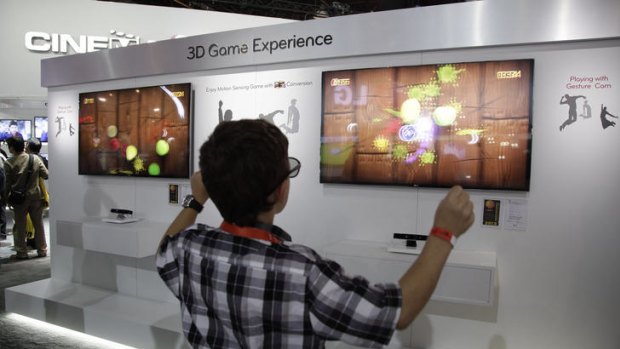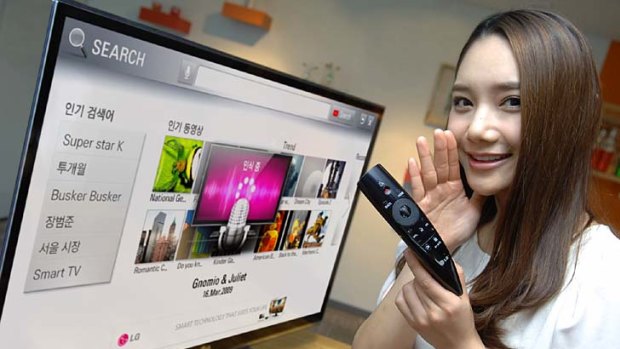By Asher Moses in Las Vegas
“Hi TV” – Welcome to the future of technology where, judging by the gear on display at the Consumer Electronics Show in Las Vegas, we'll be interacting with all of our gadgets via voice and even gestures.
This year everything from our smartphones to our TVs to our laptops will be able to see, hear and understand us – breaking down perhaps one of the final barriers between man and machine. Even “smart” fridges, such as one launched at CES by LG, are being built with voice recognition capabilities.

Amanda Musso, an actress, draws on the new LG Electronics PenTouch TV in a demonstration at CES.
“Voice is the most natural human-computer interface – everyone knows how to use their voice,” Jason Stirling, senior vice president at voice recognition firm Nuance Communications, told this website.
Stirling said the potential of voice had been unlocked after the commercialisation of “natural language understanding”, which has enabled machines to not only hear us but to understand what we mean.

Ed Giorgano, artist with Sharp Electronics, draws a portrait of Jeff Albregts on a new Aquos Board Television at CES.
Some early successful implementations driving mainstream appeal include the Siri personal assistant on the iPhone 4S and Microsoft's Kinect accessory, which is now available on both Windows and the Xbox 360 and can be used to not only play motion-controlled games but to also issue commands to the computer or games console and search the web.
At CES, LG and Samsung launched voice and gesture recognition technology on their TVs, while Nuance provided voice recognition for Ultrabook laptops shown off by Intel. These are due for release in Australia this year.
Stirling said never before had there been a greater consumer demand for constant and unlimited access to content, devices and messaging via technology, but the unlimited access must be fast, easy and simple.
“We're moving to a future where technology and the web are ubiquitous in our lives, even more so than today,” said Stirling.

A boy plays with a motion sensing 3D version of the video game Fruit Ninja at the LG exhibit at CES.
“The objects around us will be connected to the web and we'll interact with them using our voice.”
Philip Newton, head of audio-visual at Samsung Australia, said the Samsung interactive TV features would understand Australian accents and slang.

LG's new TVs allow you to speak to them.
Users start by saying “hi TV” before issuing commands such as “channel up”, “channel two” and “web browser”. The TVs can also be controlled using hand gestures.
In addition to powering voice controls on Ultrabooks, Nuance at CES launched Dragon TV, which will be used to add voice recognition support to TVs, set-top boxes and other devices.
Apple's expected iTV will also likely feature a version of Siri, which on the iPhone can do everything from sending text messages or email to scheduling meetings and reminders and answering curly questions.
Some vendors including Microsoft and Samsung are opening their voice and gesture recognition platforms to developers – paving the way for a range of innovative apps that use the functions to solve new problems.
Startup Vlingo was one such developer, launching a voice control app for televisions during CES.
"If you are sitting on your couch you can just use your voice to control your TV, set-top box, cable-box or whatever," Vlingo's Chris Barnett told AFP.
"The TV will talk back to you in Virtual Assistant mode; ask what you want to see and drill down into what you are looking for. It is like Apple's Siri, only for your TV, only better."
Vlingo said its Virtual Assistant software lets people tell televisions what they want it to do or find.
Viewers could ask assistants to find shows with particular actors or in preferred genres, or tell televisions to record or rent specific films or television programs.
Stirling said our interactions with technology would become more personal and more instantaneous while requiring less of our direct physical attention.
In fact, Stirling believes that any electronic device in the home could include voice in its user interface, enabling significant benefits for the elderly, infirm and disabled as well as productivity benefits across the country.
We'll also be using voice to access our bank details and as a layer of security on personal devices, he said.
“Imagine simply asking your TV to turn on and requesting your program as opposed to managing 3-4 remote controls,” he said.
“Our personal devices will recognise our voice and only respond to our commands, not the commands of others.”
- with AFP
Asher Moses travelled to Las Vegas as a guest of Samsung